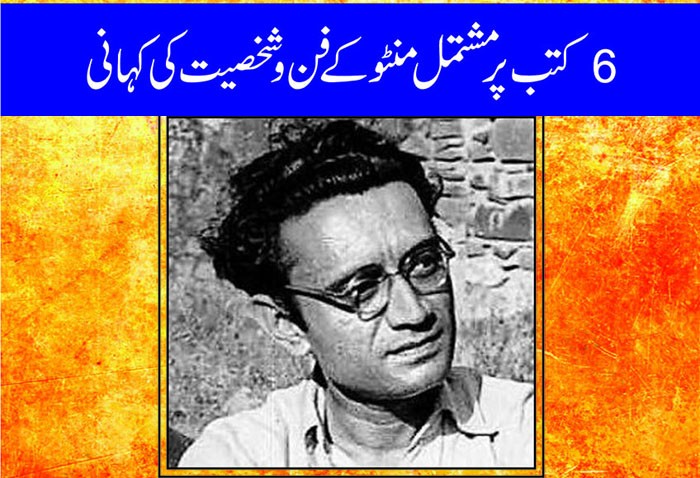
A six-volume compilation on Manto is rich with essays on his work

The fascination with Sadat Hasan Manto is endless. A few years ago on his 100th birth anniversary a lot of books were published on various aspects of his work and personality. It appears the fascination has not died down as more are being published like the six volumes by Bookage Publications.
The six volumes are about Manto’s own works and what has been written on him since. Manto was much reviled and admired -- he was always in the public eye and at the centre of some controversy. In a society that may not be tuned into art and literature, he had a flare for attracting scandal and notoriety.
The public storm gathered strength because Manto was against the hypocrisy and double standards this society specialises in. He was upfront in wanting to tear the veils that hid the bad from the perceived good, beauty from ugliness, and separated those who genuinely cared from those who exploited others in the name of the same noble value. His mocking and daring stance did not let Manto rest in peace even after his death. He challenged the mighty, the famous and the rich, and that led to a backlash exceeding the principle of measured or proportionate response. It made him notorious and that may not have been the worst thing for a writer seeking fame and publicity.
But Manto was a serious writer who took the art of storytelling, especially the short story, to a higher level. Influenced by famous French and Russian writers he made the afsana the representative form of fiction in the first half of the 20th century. He adopted the technique of conveying profound ideas in very few words, with sharp short sentences. This aphoristic quality is admired so often in poetry in this society.
Five volumes of the six are in Urdu, the sixth is in English. Great Manto is not only the translation of Manto’s work in English but actually comprises what others have written on him in English in Pakistan. The writings in English exposes Manto to a different set of readers within the country, as well as outside it. Some may be inspired to cross the language divide to read and feel about Manto, they may have earlier been either shielded from this knowledge because of their medium in the education process. That Manto has a following in the English speaking world of the subcontinent speaks for his bipartisan readership and appeal. Edited and probably selected by Shahzada Irfan Ahmed, the various articles and translations are by well-known writers and critics such as Dr Waqas Khwaja, Abdus Sattar Ghazali, Pankaj Mishra, Agha Ameer Hussain, Dr Muhammed Umar Memon, Rashid Malik, Sarmad Sehbai, Aftab Malik, Intizar Hussain, Jairaj Singh, Ali Sethi, Majid Sheikh, Asha’ar Rehman, Muhammed Badar Sulehria, Naila Inayat, Ali Usman, Qaisera Faisal, and Professor Nasser Ahmed. A number of discussions by groups of various writers and critics like Zahida Hina, Muhammed Ali Siddiqui, Badar Alam, Fahmida Riaz, Ajmal Kamal, Asif Noorani, Ghazi Salahuddin, Wusatullah Khan and Hasan Manzar are also included. Some translations - not mentioned where these have been selected from – have also been made part of the volume.
Translating Manto into English must have been a challenge; this had been discussed by Jawad Rauf in his article titled "Translating Saadat Hasan Manto". The article critiques Khaled Hasan’s translations of Manto’s short stories and finds many shortcomings in them.
Of the five volumes in Urdu, four are about what other writers and columnists have written about Manto. These have been divided into various heads like ‘Namvar Manto’, ‘Manto Ka Inkaar’, ‘Manto ki Pehchan’ and ‘Sab Sey Bara Afsana Nigar’. ‘Manto Saaz’ is the selection of his afsanas by Faisal Sulehria, so as to give an indication of his writings and finer aspects as a fiction writer. Other articles are also by famous writers and junior contemporaries: some who are writing now, some who knew him personally and some who were not enamoured by what he wrote.
These articles in Urdu and in English can be very useful, the fact that they have been collected in one set is main function of this six-volume edition. It appears there was no overarching editor supervising the enterprise, in fact it was distributed among many such as Faisal Sulehria, Daanish Ali and Tahir Asghar.
Many now have started to write in English and there has been a refrain of criticism that Pakistani literature, in various languages including Urdu, has not been translated into English. Though much is lost in translation, it must be said that translations allow the literature to reach a larger and more global audience that may include opinion makers and critics who determine literary taste and standards. Perhaps a greater effort should be made to translate Pakistani writers into English; Manto is a good beginning, though a challenging one.